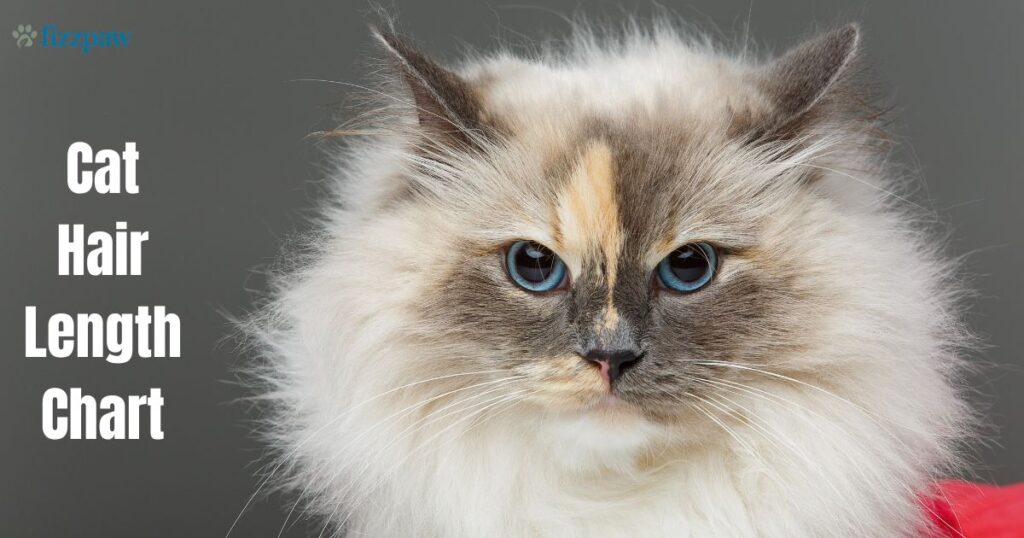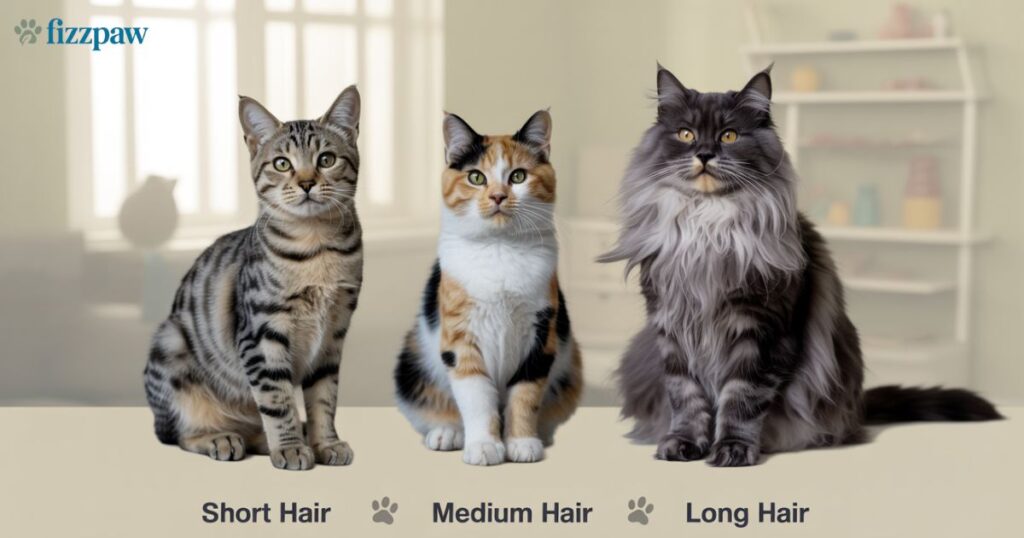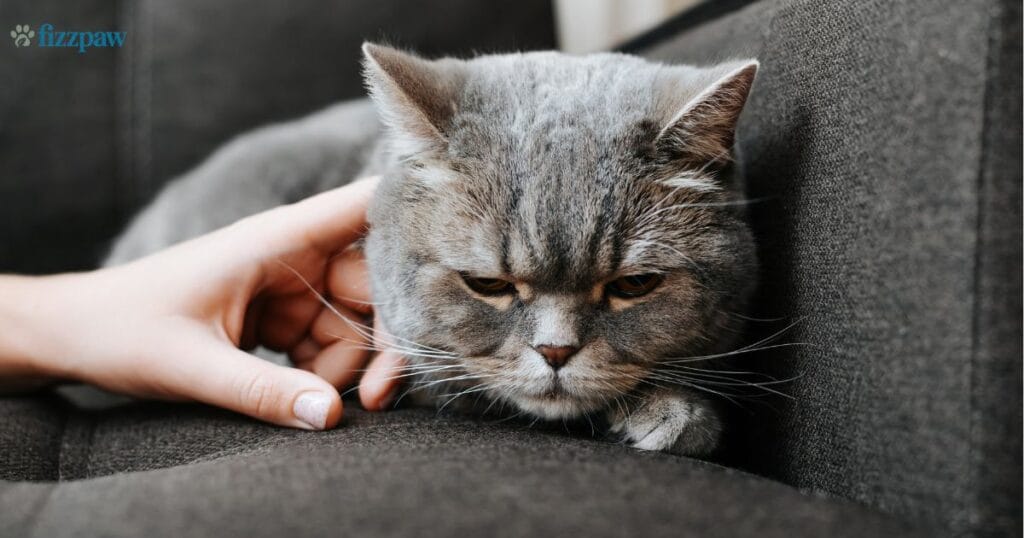Do you wonder why some cats require a daily bathing routine and others are fine by themselves? The following Cat Hair Length Chart breaks everything down in your own words. From sleek, short-haired kittens to fluffy, long-haired breeds of cats, each coat type has the appropriate level of attention to detail.
There will also be information on rare breeds of cat with no hair, as well as those soft and fluffy-haired cat breeds that are common to the domestic market. Every cat’s fur is different and knowing more about the texture and thickness of their fur will help keep your cat clean, happy and healthy. If you’re considering one for your new pet or simply want to know which fur is perfect for you.
Cats come in all sorts of coats: long, short, curly, even no coat at all! The Cat Hair Length chart helps to determine what kind of hair your cat has and how you can care for it. From short-haired cat breeds to long-haired breeds of cat and even cat breeds without hair You’ll discover the way that texture and thickness of fur influences grooming and maintenance.
Cat Hair Length Chart by Breed

All fur is not alike! Here is a useful chart that categorizes breeds by hair length. Also included is information on their grooming requirements and their origins. Choosing the right cat involves many factors, and our cat hair length chart helps simplify your decision.
| Breed Name | Hair Length | Approx. Length | Description | Origin | Grooming Needs |
| Abyssinian | Short | < 2 cm | Short, ticked coat with a distinctive agouti pattern. | Ethiopia (Abyssinia) | Low |
| American Shorthair | Short | < 2 cm | Short, close-lying fur that requires minimal grooming. | USA | Low |
| Balinese | Semi-Long | 3–6 cm | Silky, medium-length fur with colorpoint markings. | USA | Medium |
| Bengal | Short | < 2 cm | Sleek, soft coat with marbled or spotted patterns. | USA | Low |
| Birman | Semi-Long | 3–6 cm | Semi-long, silky coat with pale color and white “gloves.” | Burma/France | Medium |
| Bombay | Short | < 2 cm | Shiny, black coat with panther-like appearance. | USA | Low |
| British Shorthair | Short | < 2 cm | Dense, plush coat with a soft undercoat. | UK | Low |
| Burmese | Short | < 2 cm | Short, shiny coat, fine and silky. | Burma (Myanmar) | Low |
| Chartreux | Short | < 2 cm | Woolly, dense blue-grey coat. | France | Low |
| Cornish Rex | Short | < 2 cm | Curly, soft coat with no guard hairs. | UK (Cornwall) | Medium |
| Devon Rex | Short | < 2 cm | Short, curly coat with fine hairs and fragile texture. | UK (Devon) | Medium |
| Egyptian Mau | Short | < 2 cm | Spotted coat with a naturally athletic build. | Egypt | Low |
| Exotic Shorthair | Short | < 2 cm | Short, plush coat; Persian features without the long hair. | USA | Medium |
| Himalayan | Long | > 7 cm | Long, luxurious coat with Siamese-like colorpoints. | USA | High |
| Japanese Bobtail | Short to Semi-Long | <2 to 3–6 cm | Silky coat in both short and semi-long varieties. | Japan | Low to Medium |
| Korat | Short | < 2 cm | Short, silver-tipped coat; glossy and close-lying. | Thailand | Low |
| LaPerm | Short to Long | <2 to >7 cm | Unique curly/wavy coat; soft and springy texture. | USA | Medium |
| Maine Coon | Medium to Long | 2–7 cm | Thick, shaggy fur; bushy tail and ruff around the neck. | USA (Maine) | Medium to High |
| Manx | Short | < 2 cm | Dense double coat; can also be semi-long. | Isle of Man | Low to Medium |
| Norwegian Forest Cat | Long | > 7 cm | Thick, water-resistant double coat with a full ruff. | Norway | High |
| Oriental Shorthair | Short | < 2 cm | Sleek, fine coat in a variety of colors and patterns. | USA | Low |
| Persian | Long | > 7 cm | Dense, full coat requiring daily care. | Iran (Persia) | Very High |
| Ragdoll | Medium to Long | 2–7 cm | Soft, colorpoint coat with minimal undercoat. | USA | Medium |
| Russian Blue | Short | < 2 cm | Short, dense, silvery-blue coat. | Russia | Low |
| Scottish Fold | Short | < 2 cm | Dense, soft coat and folded ears. | Scotland | Low |
| Selkirk Rex | Short to Long | <2 to >7 cm | Thick, curly coat that can vary in length. | USA | Medium to High |
| Siamese | Short | < 2 cm | Fine, short coat with striking point coloration. | Thailand | Low |
| Siberian | Semi-Long | 3–6 cm | Triple coat with water-resistant outer layer. | Russia | High |
| Singapura | Short | < 2 cm | Short, fine ticked coat. | Singapore | Low |
| Somali | Semi-Long | 3–6 cm | Ticked coat similar to Abyssinian but longer. | USA | Medium |
| Sphynx | Hairless | N/A | Nearly hairless; warm to touch; needs skin cleaning. | Canada | Medium (bathing required) |
| Tonkinese | Short | < 2 cm | Soft, medium-dense coat with rich color points. | Canada/USA | Low |
| Turkish Angora | Semi-Long | 3–6 cm | Soft, flowing coat with fine texture. | Turkey | Medium |
| Turkish Van | Semi-Long | 3–6 cm | Semi-long, water-resistant coat with unique color placement. | Turkey | Medium |
Cat Hair Lenght Chart: Highlights of Popular Breeds
This cat hair length chart divides cats into three main coat types: short, medium, and long.

- Short-haired Cats Breeds like those of the American Shorthair and Bengal are ideal for pet owners who need minimal grooming while still retaining the look of fashionable, sleek coats.
- medium-haired cat: The Ragdoll, as well as the Balinese, have soft fur that is easy to control by grooming bi-weekly to avoid knots.
- Long-haired Cats If you are a fan of lavish pampering, Persian and Maine Coon cats sport stunning coats, but require careful attention to avoid matting.
- Hairless Cats: Although Sphynx cats might not have fur, they still require particular care, which includes weekly baths as well as regular moisturizing of their skin.
- Proper grooming is essential for all coat types — see our vet-backed guide on safe cat grooming to know what products to use.
Types of Cat Hair Length: Short, Medium, Long, and Hairless
The lengths of coats for females are typically separated into four different categories, having distinct characteristics and grooming requirements.
Short-haired Cats
Short-haired breeds are characterized by fur lengths that range from 0.5 to one inch. These cats typically have two coats that cover them with long, sleek fur that needs only minimal grooming. The cats shed more in certain seasons. However, just a few minutes of brushing every week can keep the amount under control. This is perfect for owners with busy schedules who need an easy-to-maintain pet.
Medium-haired Cats
Medium-haired cats’ fur is around one to two inches wide. A lot of them are covered in thick, double-coated coats that are silky and fluffy. To ensure their fur stays healthy and free of tangles brushing them two times a every week is recommended.
Long-haired Cats
The luxurious coat of cats with long hair often exceeds 2 inches, and comes with a thick tri-coat (guard hair Awn hair, guard hair, as well as down hair). Breeds such as Maine Coons as well as Persians require regular brushing to avoid tangles. They also have frequent shedding during changing seasons.
Hairless Cats
Hairless breeds such as the Sphynx do not have a real coat, but instead are covered with an ethereal layer of fuzz. They require regular baths to control oil production on their skins and regular cleaning of their ears.
Infographic Idea
Create a visually appealing graphic that demonstrates each coat’s texture as well as its thickness and maintenance level to serve as an easy reference guide.
Discomfort from mats or tangles? Try gentle natural pain relief for cats.
Cat Hair Length Chart Explained: What Determines Your Cat’s Coat Type?
The length of a cat’s fur isn’t just for appearances, and it’s due to their genetics.
Genetics Matter
A particular gene known as FGF5 plays a significant role in the length of the fur of a cat develops. If there’s any change (mutation) within this gene, a cat can end up having a thicker, longer fur, similar to what that you observe on Persians and Maine Coons.
Adapted by Nature
Certain cat breeds have created coats that match the climate they are from.For instance, Siberian cats have long thick coats that protect them from harsh winters while short-haired Bengals have adapted to warmer climates.
Kitten Fur: How to Predict Its Adult Coat
Are you wondering if your kitten is likely to become a gorgeous long-haired kitten? Look out for these indicators.
Hair Growth Phases
Kittens were born sporting the soft, fluffy coat known as velus fur. This coat transforms into an adult coat at about six months old. If you observe their fur’s texture and density in the early stages, you can anticipate the future grooming requirements.
Indicators of Longer Coats
- Fluffy tails
- Furry ear flaps and around paws
- Soft tufts of hair along their underbelly
If the fur of a kitten feels particularly soft, it’s likely they’ll grow into a medium and long-haired adult.
Cat Fur vs. Cat Hair: Understanding the Difference
Scientifically speaking, cat hair and cat fur are essentially the same—they’re both composed of the protein keratin.
But, the term “fur” usually refers to the thicker, shorter coats of animals that have a thick coats, while hair is a reference to longer, finer hair like the ones found in breeds like The Maine Coon.
Grooming Implications
Although the terminology can vary, however both fur and hair require regular grooming to ensure your cat is happy and healthy.
Grooming Tips Based on Hair Length
- The Short-haired Cat: Every week cleaning using a rubber brush get rid of hair that is loose.
- Medium-haired cats: Brush them about twice a week using a bristle or slicker brush to keep their coat smooth and tangle-free.
- Long-haired Cats should be brushed daily to avoid mats, and pay attention to areas with high shedding, such as the tails, as well as underbellies.
- The hairless cat can enjoy gentle daily baths and ear cleansings with moisturizer as required.
Related Article: Can I Use Human Shampoo on Cats? Vet-Backed Guide for Safe Cat Grooming
Choosing the Right Cat Hair Type for Your Lifestyle
Things like grooming time, shedding levels, and allergies can all be affected by your cat’s coat, which is why this cat hair length chart is helpful when choosing the right feline companion.
- Low maintenance: Breeds like the American Shorthair and Bengal are easy to care for, needing just a little brushing now and then.
- Great for families: Ragdolls are calm and affectionate, making them an ideal match for households with kids.
- Allergy-friendly: No cat is completely hypoallergenic, but the Sphynx is a good option for people with mild cat allergies.
Final Thoughts on Cat Hair Length
Every cat’s coat is distinct as their individual personality. From the sleek elegance of the elegant Bengal to the luxurious elegant look of the Persian, knowing the fur of your cat will aid in giving them the attention they need.
Are you a fan of the coat of your pet? Offer them some love by following proper grooming practices. Don’t be afraid to ask your veterinarian about any concerns with your cat’s hair or skin, or the cat hair length chart.
You’re now ready to enjoy your cat’s gorgeous fur to the max!
FAQ
What is the length of a cat’s hair?
A cat’s hair can range from less than 1 inch (short) to over 2 inches (long).
Is my cat medium long-haired?
If your cat has fluffy fur with feathering or tufts, it’s likely medium or long-haired.
What determines a cat’s fur length?
A cat’s fur length is determined by genetics, mainly the FGF5 gene.
How long is a long cat’s hair?
Long cat hair is typically 2 inches or more in length.
How do I know if my cat has long or short hair?
Short hair is sleek and smooth, while long hair is fluffy with visible tufts and requires more grooming.


